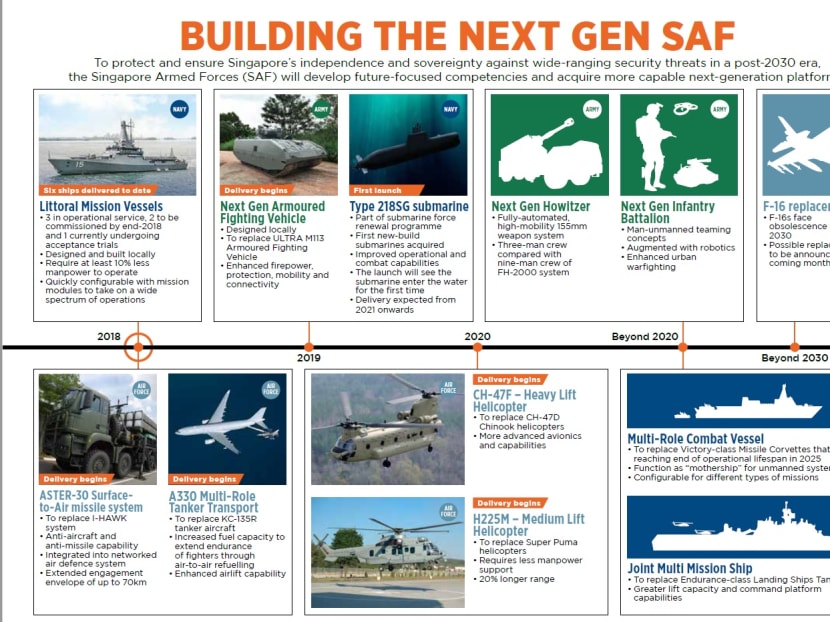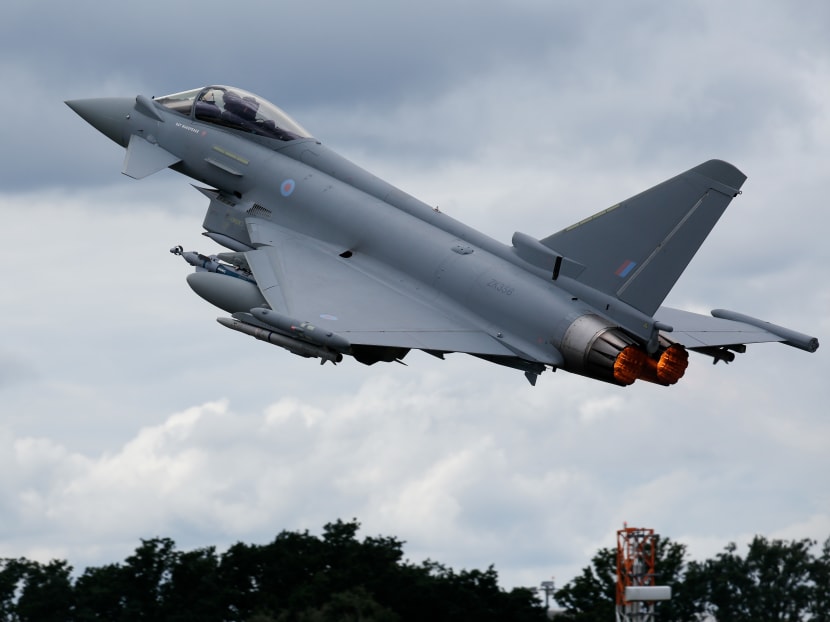Govt likely to decide on replacement for F-16s in next few months
SINGAPORE — The Government will likely make a “definitive decision” in the next few months on the replacement aircraft for its ageing F-16 fleet of fighter jets.
SINGAPORE — The Government will likely make a “definitive decision” in the next few months on the replacement aircraft for its ageing F-16 fleet of fighter jets.
Speaking to reporters on Friday (June 29), Defence Minister Ng Eng Hen said options on the market include the Eurofighter Typhoon, Lockheed Martin's F-35, Chinese-made stealth fighters, the Russian Sukhois, and 4.5- and 5th-generation stealth fighters.
The Navy, meanwhile, is set to have new Multi-Role Combat Vessels — combining manned and unmanned elements — replacing its ageing missile corvettes. The vessels will be built after 2020.
Financial news agency Bloomberg reported in 2016 that Singapore had held off a decision to buy four F-35s — billed as the world’s most advanced fighter aircraft — by around 2022, with the option of adding another eight.
Around the world, F-16s will become obsolete after 2030, Dr Ng noted. “It’s not as if you can find production lines or you can find spare parts… Militaries will stand them down,” Dr Ng said.
Singapore’s F-16 aircraft, which came into service in 1998, are presently undergoing a mid-life upgrade. The upgrade, which is expected to take place over five to six years, started in 2016.
Replacing ageing fighter aircraft requires a “lead time of eight to 10 years”, Dr Ng said. Time is needed to train pilots and find the training grounds for them, he added.
Choosing a suitable replacement is not a “theoretical exercise”, Dr Ng said, and factors such as cost, inter-operability and maintenance have to be considered.
For instance, the aircraft must be able to work with other platforms in the SAF across air, land and sea. “That’s crucial because you have to talk... For all militaries, you don’t defend with single platforms. You defend with an array of platforms, not only air platforms, but land and sea,” said Dr Ng.
Ease of maintenance is also key. While a certain aircraft could check all the boxes, it would not be useful if it is hard to maintain, unserviceable and on the ground most of the time, he said.
Dr Ng also cited the need to prevent “concentration failure” by having different types of aircraft in its fleet.
A fleet with only one type of aircraft could be grounded if problems arise, Dr Ng said. “It won’t make sense to have more F-15s, for example, because of that. So you need to find another type of aircraft that can fulfil this,” he explained.
Infusing new platforms and tapping smart technology are the SAF’s approach to dealing with the manpower challenges that will set in by 2030 and be a “significant disruptor”, Dr Ng said.
By 2030, the pool of full-time national servicemen is set to shrink by one-third, due to the country’s falling birth rates.
NEW NAVAL CAPABILITIES
At sea, the Navy will replace its ageing missile corvettes, which will reach the end of their lifespans by 2025, with new Multi-Role Combat Vessels.
The vessels, comprising manned “motherships” and satellite unmanned ships, will be armed with lethal, less lethal and non-kinetic capabilities, for instance.
The Navy’s Formidable-class Frigates, in operation since 2006, will also undergo a mid-life upgrade. This is to ensure their continued relevance and effectiveness, particularly in anti-submarine and anti-air-defence capabilities.
On land, the Army will add the manpower-saving Next-Generation Armoured Fighting Vehicle to its fleet next year, replacing the ageing M113 Armoured Fighting Vehicle. The new vehicle can fire on the move and cut the reliance on manpower by 20 per cent, said Dr Ng.
Also to be introduced after 2020 is the fully automated 155mm Next-Generation Howitzer weapon system. Mounted on a vehicle, the system allows soldiers to “shoot and scoot”, avoiding counter-battery fire. Besides increased firepower, it will require only three crew to operate, compared with the current nine for the FH-2000 system.
The next-generation infantry battalion will also be a mishmash of manned and unmanned elements. Soldiers could tinker with palm-sized unmanned aerial vehicles and sophisticated electro-optical systems able to cue them to surrounding dangers, look around corners and follow them like a “master and slave”, Dr Ng said. These projects are still in experimentation.

During the 1.5-hour interview, Dr Ng also reiterated that the threat to Singapore is at its highest since the Sept 11, 2001 attacks and the Bali bombings the following year.
The terror threat will persist for the next few decades, with no signs of abating. Terror attacks, cells, people detained and the reach of terror networks have been on the rise, he noted.
The SAF has taken steps to deal with the threat for the long term, including training soldiers to prepare for terror attacks.
But the transnational nature of the threat also means having to work with other countries. “You’ve to work with partners around you and to deal with it at source. No country can take the position that I will only deal with it when it comes in my borders,” said Dr Ng.
The Government has projected defence spending up until 2030 and, barring unforeseen circumstances such as a terror attack, he does not foresee a spike in defence spending in the next decade.









